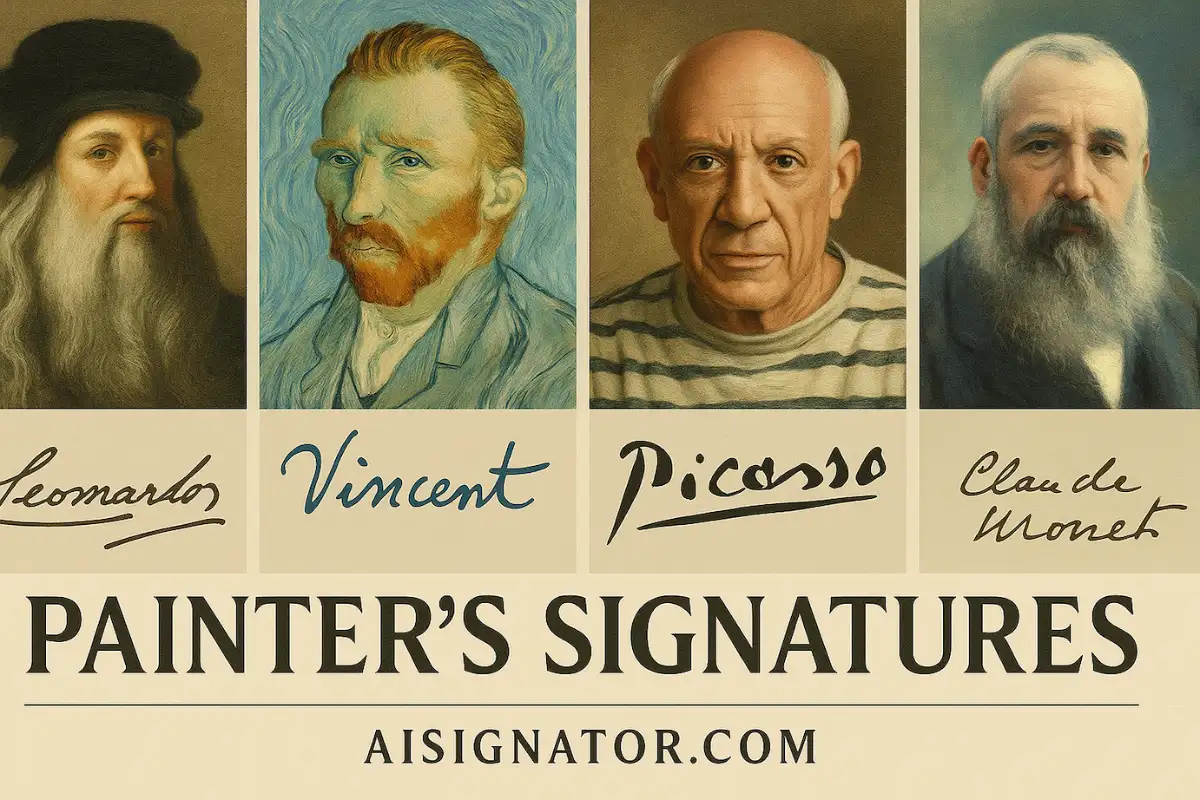🧾 Introduction
A painter’s signature is more than just a name scribbled on a canvas—it’s a mark of authenticity, a symbol of artistic identity, and often a key to determining the value of an artwork. Art collectors, enthusiasts, and even casual observers are drawn to these signatures because they connect us to the creative mind behind the masterpiece.
Whether you’re buying art, appraising a piece, or just curious, knowing how to interpret and identify a painter’s signature is essential. This guide covers 63 iconic examples, expert tips, and even artistic signature ideas to inspire your own creativity.
🖌️ What Is a Painter Signature on a Painting?
A painter signature is the handwritten mark an artist leaves on their work, typically on the front or back of the canvas. It serves as a personal seal, confirming the artist’s authorship and completing the artwork’s narrative.
Signatures vary widely: some artists use their full names, initials, or even monograms. Importantly, an art signature is not just an identifier—it’s part of the visual language of the artwork itself.
Common locations for signature on a painting:
- Bottom right corner (most frequent)
- Bottom left corner
- On the back of the canvas or stretcher
- Hidden within the composition itself
🎭 Signature Arts: Common Styles Across Art Movements
Across art history, signature arts reflect broader aesthetic trends:
- Impressionism (Monet, Renoir): soft, flowing signatures blending with brushwork
- Cubism (Picasso, Braque): geometric, fragmented initials
- Surrealism (Dalí, Magritte): elaborate, dreamlike autographs
- Abstract Expressionism (Pollock, Rothko): gestural, sometimes minimal
- Pop Art (Warhol, Lichtenstein): bold, graphic, sometimes printed
- Contemporary Art (Hirst, Kusama): conceptual, often integrating symbols
Understanding these trends helps art lovers and collectors contextualize and recognize authentic signatures.
🖼️ 63 Unique Painter Autograph Examples (With Images)
Let’s explore some of the most iconic painter signatures from around the world:
Pablo Picasso – A Confident, Fluid Script
Pablo Picasso (1881–1973), born in Spain, is one of the most influential artists of the 20th century and a co-founder of Cubism. His artistic journey spanned painting, sculpture, ceramics, and printmaking. Some of his most iconic works include Les Demoiselles d’Avignon, Guernica, and The Weeping Woman. Picasso’s style evolved from the Blue and Rose periods to Cubism, Surrealism, and Neoclassicism, making him a central figure in modern art.
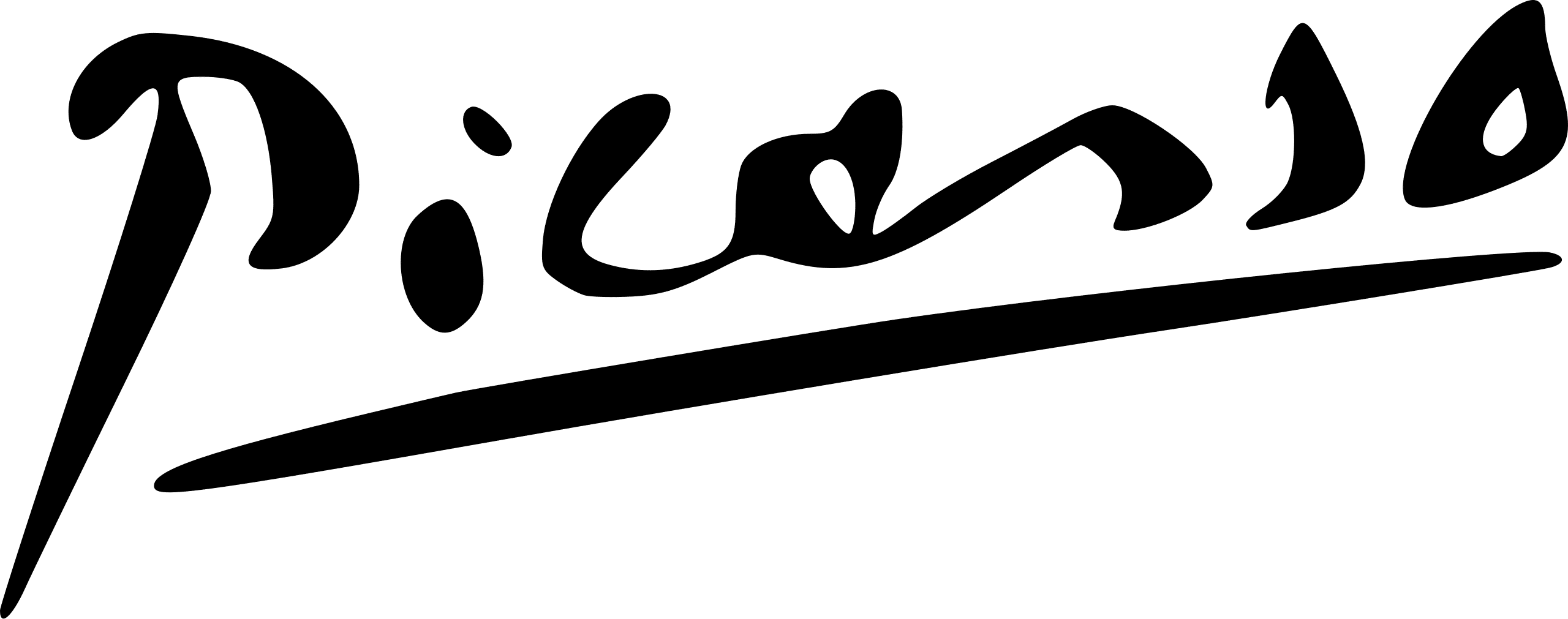
Picasso’s signature is known for its bold, confident flow, reflecting his dominant personality and fearless innovation. Typically, he signed “Picasso” in a swift, fluid script, sometimes integrating it directly into the composition. His autograph became almost a logo—synonymous with artistic genius, rebellion, and creative mastery. It carries immense market value and is widely imitated by forgers, making authentication crucial.
👉 Discover: How to Spot Forged Picasso Autographs
Salvador Dalí – Flamboyant, Surreal Flourishes
Salvador Dalí (1904–1989), from Spain, was one of the most famous Surrealist artists, known for his eccentric personality and dreamlike, bizarre imagery. His masterpieces include The Persistence of Memory, Swans Reflecting Elephants, and The Elephants. Dalí’s work spanned painting, sculpture, film, and even fashion, always pushing the boundaries of the unconscious mind and artistic reality.

Banksy – Elusive, Stencil-Inspired Mark
Banksy, an anonymous British street artist active since the 1990s, is known for his politically charged, satirical street art. His iconic works like Girl with Balloon and There Is Always Hope have appeared on walls across the world, blending graffiti with dark humor and activism.

Banksy’s “signature” is often a stencil tag, reflecting his roots in street art and his desire for anonymity. Sometimes he leaves no mark at all, reinforcing the mystery around his identity. When present, the stencil signature is bold, direct, and highly collectible, though its authenticity is fiercely debated in art circles.
Andy Warhol – Playful, Pop-Inspired Script
Andy Warhol (1928–1987), an American artist, was a leading figure in the Pop Art movement, celebrated for works like Campbell’s Soup Cans and Marilyn Diptych. He revolutionized the relationship between artistic expression, celebrity culture, and mass production.
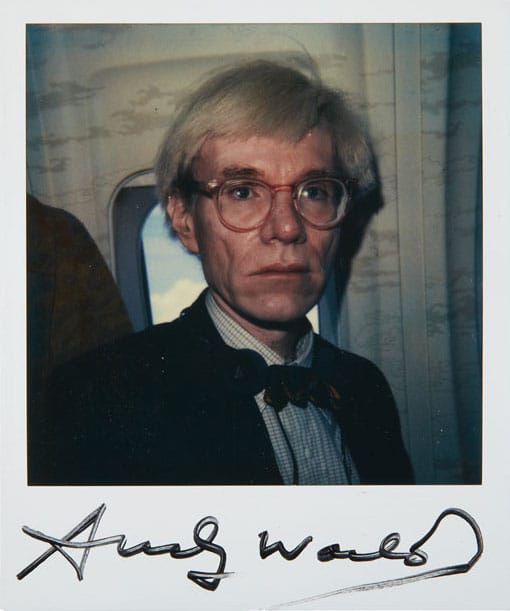
Warhol’s signature often appears as a playful, casual script with a carefree flair, mirroring his fascination with consumerism and fame. Whether signed on canvas or screen prints, his autograph became a cultural symbol in itself, merging art and commercial branding.
Vincent van Gogh – Heavy, Emotional Stroke
Vincent van Gogh (1853–1890), a Dutch Post-Impressionist master, produced over 2,000 artworks, including Starry Night, Sunflowers, and The Bedroom. Despite a life marked by struggle and mental illness, his influence reshaped modern art.

Van Gogh’s signature is marked by heavy, deliberate strokes, often “Vincent” alone, reflecting his intimate, emotional connection to his work. The intensity of his autograph mirrors his impassioned brushwork, making it one of the most recognized signatures in art history.
Claude Monet – Elegant, Balanced Mark
Claude Monet (1840–1926), a French Impressionist and a founder of the movement, is best known for his Water Lilies series, Impression, Sunrise, and Woman with a Parasol. His exploration of light and color revolutionized landscape painting.
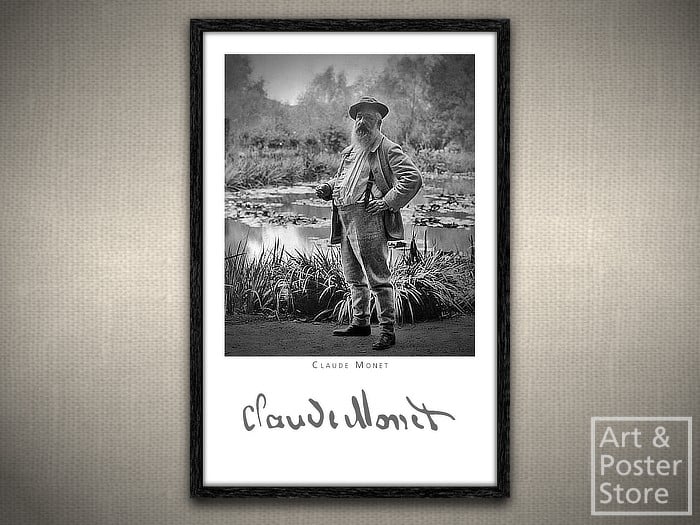
Monet’s signature is elegant and harmonious, typically placed unobtrusively in a corner, complementing the composition. It embodies the Impressionist ethos of capturing fleeting moments, blending seamlessly with the atmospheric quality of his paintings.
Leonardo da Vinci – Rare, Historic Inscription
Leonardo da Vinci (1452–1519), the quintessential Renaissance genius from Italy, is famed for masterpieces like Mona Lisa, The Last Supper, and Vitruvian Man. His work spanned painting, engineering, anatomy, and invention.

Da Vinci rarely signed his artworks, making authentic inscriptions extraordinarily rare. When present, his marks were precise and scientific, reflecting his multifaceted mind. Most attributions today rely on historical documentation and technical analysis rather than a visible autograph.
Robert Wood – Clear, Traditional Signature
Robert Wood (1889–1979), a British-American landscape painter, became known for idyllic depictions of the American countryside, such as October Morn and Springtime. His works became popularized through prints and calendars.
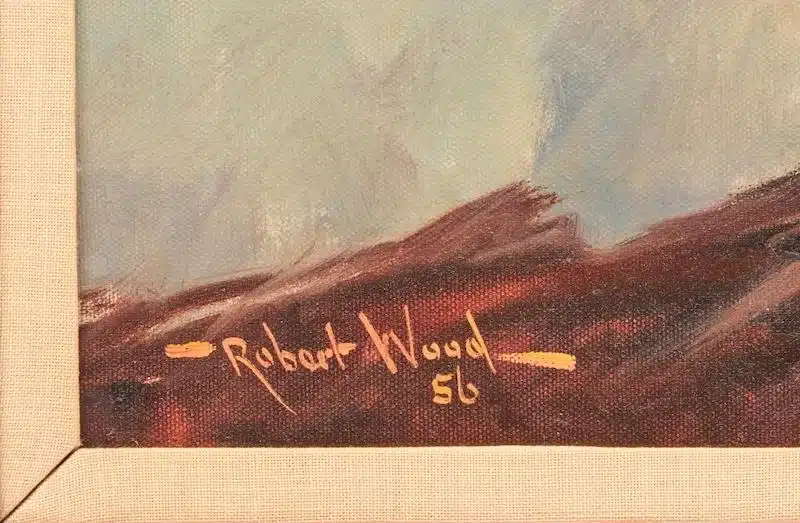
Wood’s signature is clear, traditional, and prominently placed, often reading “Robert Wood” in a legible, flowing hand. His consistent signing practice has helped maintain the integrity and collectibility of his prolific body of work.
Keith Haring – Graffiti-Like, Energetic Line
Keith Haring (1958–1990), an American artist, emerged from the 1980s New York graffiti scene, known for bold lines, vivid colors, and iconic figures. His work, like Radiant Baby and Crack is Wack, fused pop culture and social activism.

Haring’s signature is an extension of his street art style—graffiti-like, quick, and energetic. Sometimes accompanied by his trademark symbols, his autograph is playful yet politically charged, reflecting his commitment to accessible, public art.
Discover the personal side of power.
Our presidential signatures article reveals the hidden meaning behind America’s most famous autographs.
Robert Rauschenberg – Experimental, Varied Mark
Robert Rauschenberg (1925–2008), an American artist, was a pivotal figure between Abstract Expressionism and Pop Art. Known for Combines—hybrid works of painting and sculpture—he challenged artistic conventions.
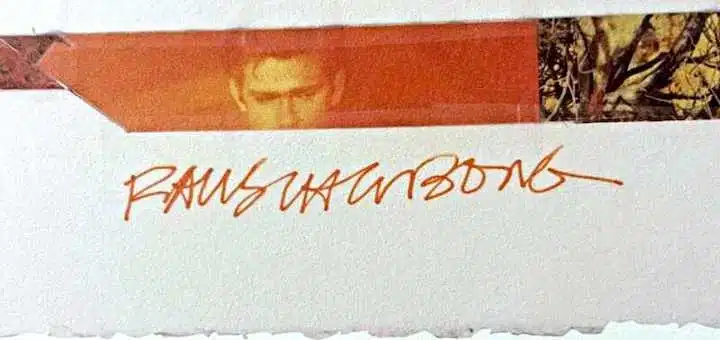
Rauschenberg’s signature varied with his experimental nature: sometimes scrawled, sometimes orderly, often integrated into his multimedia works. His mark signaled constant reinvention, aligning with his belief that art and life are inseparable.
Jean-Michel Basquiat: Raw, Childlike Scrawl
Jean-Michel Basquiat (1960–1988), a Brooklyn-born prodigy, rose from street art to international fame with his neo-expressionist works. His paintings, like Untitled (Skull) and Hollywood Africans, addressed race, power, and identity.
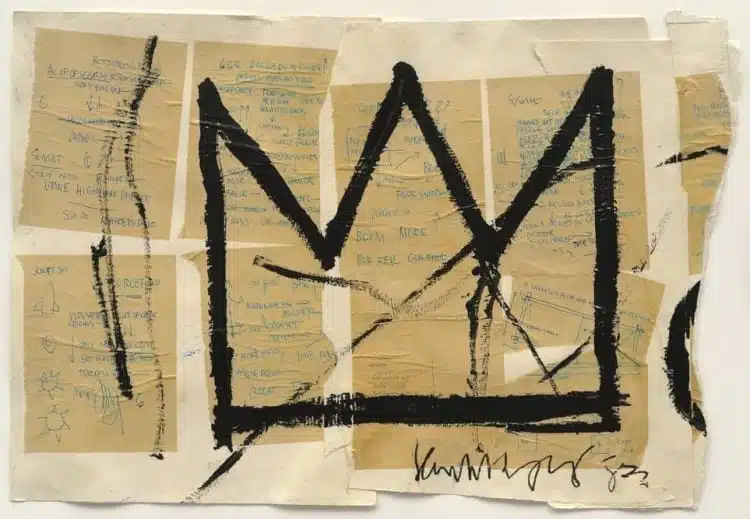
Basquiat’s signature is raw and childlike, echoing the primitive energy of his art. Often signed with a crown motif, his autograph has become an icon of rebellion and the downtown New York art scene of the 1980s.
Carlson Artist – Simple, Decorative Hand
The name “Carlson” appears in various landscape and seascape works, often attributed to lesser-known or commercial artists producing decorative art for mass markets.
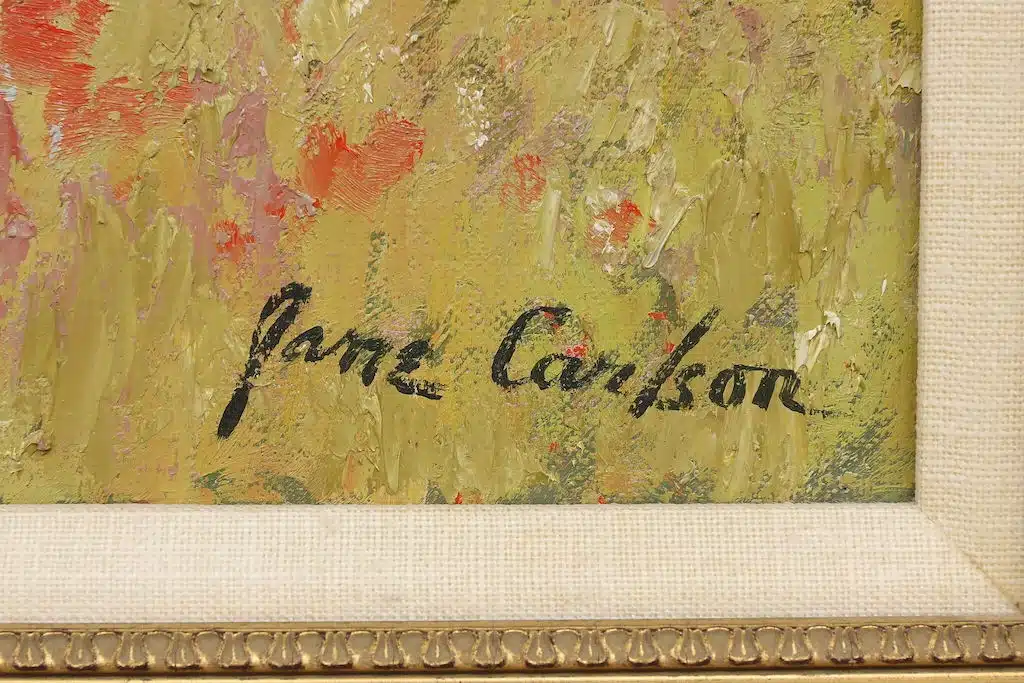
Carlson’s signature is typically simple, readable, and decorative, usually positioned clearly in the corner. While not as widely studied as major artists, its clarity aids collectors and appraisers in identifying works.
For those who admire classical scripts and calligraphic elegance, the signature of the Pope offers timeless inspiration rooted in centuries of spiritual authority.
George Grosz – Sharp, Satirical Line
George Grosz (1893–1959), a German artist and prominent member of the Berlin Dada and New Objectivity movements, is known for his biting social and political commentary. His works, like Pillars of Society, critiqued the corruption of Weimar Germany.
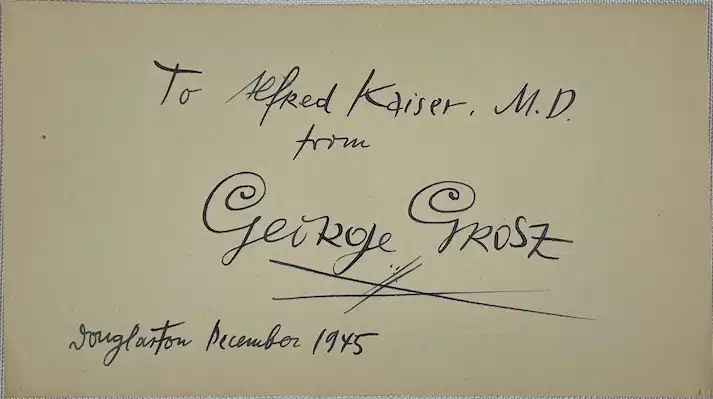
Grosz’s signature is sharp, pointed, and sometimes slightly angular, matching the satirical, incisive nature of his art. It reinforces his role as a visual critic of societal hypocrisy and decay.
Curious how Banksy’s mysterious signature influences art pricing and authentication?
👉 Explore the full breakdown in this Banksy signature analysis.
Rembrandt – Evolving, Masterly Mark
Rembrandt van Rijn (1606–1669), the Dutch Baroque master, created timeless works such as The Night Watch, The Jewish Bride, and numerous self-portraits. He remains a defining figure in Western art history.
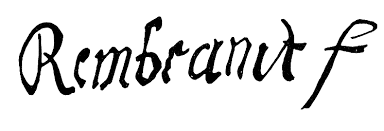
Rembrandt’s signature evolved throughout his career, from “RHL” (Rembrandt Harmenszoon of Leiden) to simply “Rembrandt,” reflecting his growing fame. His autograph, often inscribed confidently, signifies both artistic mastery and commercial awareness.
Dalí’s signature reflects his flamboyant persona, often featuring exaggerated loops and ornamental strokes, sometimes ending with a dramatic flourish or a star-like accent. His autograph conveys a sense of theatricality, individuality, and surrealism, much like his paintings. Authenticating Dalí’s signature is complex due to the proliferation of fakes, especially on prints and lithographs, making expertise essential.
Joan Miró – Playful, Abstract Mark
Joan Miró (1893–1983), a Spanish painter, sculptor, and ceramicist, was a key figure in Surrealism, known for dreamlike, biomorphic forms and a vibrant color palette. His works like The Farm and Blue Series revolutionized abstract art.
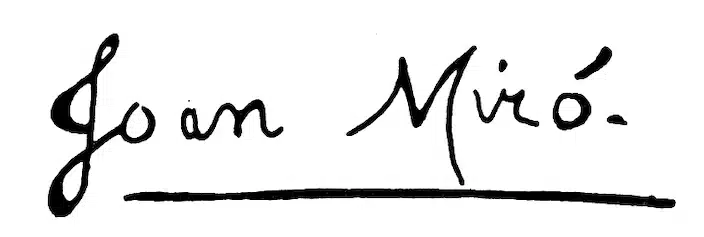
Miró’s signature reflects his playful abstraction—often simple, flowing, and lightly stylized, sometimes blending into the artwork as an organic element. It encapsulates his imaginative spirit and poetic approach to visual language.
Thomas Kinkade – Romantic, Decorative Script
Thomas Kinkade (1958–2012), an American painter, became a household name for his idyllic, glowing landscapes and cottage scenes. Nicknamed the “Painter of Light,” his works like Christmas Cottage became mass-market sensations.
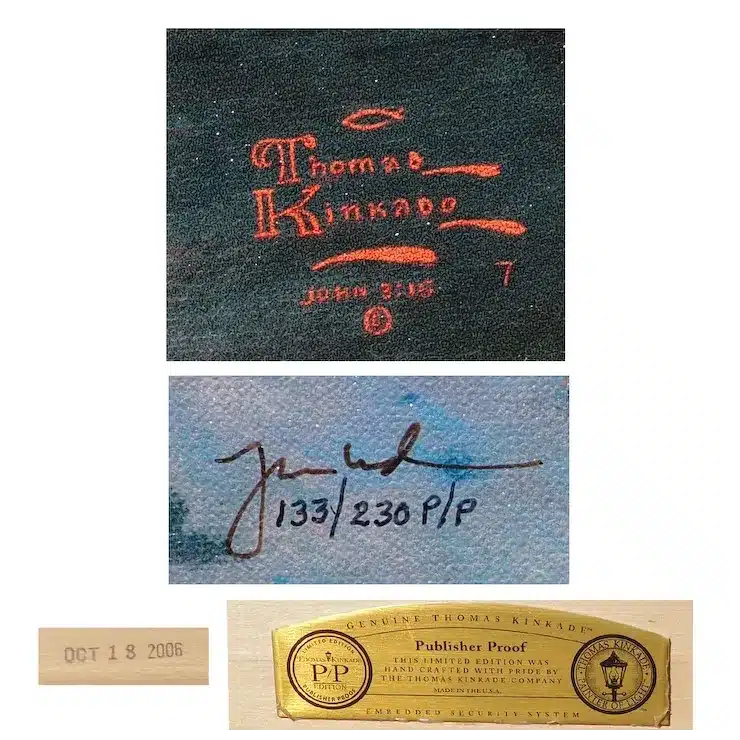
Kinkade’s signature is polished and decorative, typically placed prominently in a lower corner. It projects a sense of warmth and romance, matching the nostalgic, comforting feel of his paintings.
Jackson Pollock – Spontaneous, Gestural Mark
Jackson Pollock (1912–1956), an American painter, was a leader of Abstract Expressionism, famed for his drip technique in works like No. 5, 1948 and Autumn Rhythm. His method redefined painting as action.
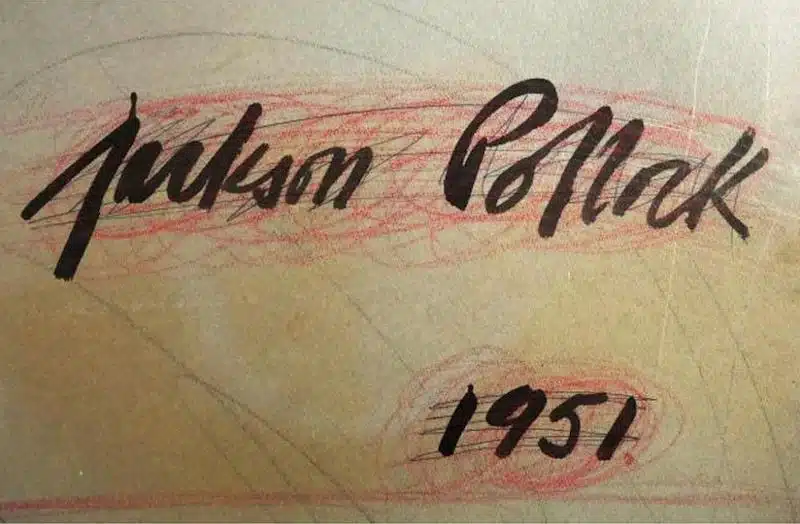
Pollock’s signature was often rapid, gestural, and somewhat chaotic, reflecting his intense, physical painting process. Sometimes barely legible, his mark blended into the energy of his canvases, embodying movement and spontaneity.
Marc Chagall – Dreamlike, Calligraphic Script
Marc Chagall (1887–1985), a Russian-French artist, is renowned for poetic, dream-filled compositions in works like I and the Village and The Birthday. His art fused modernism with folklore, love, and memory.
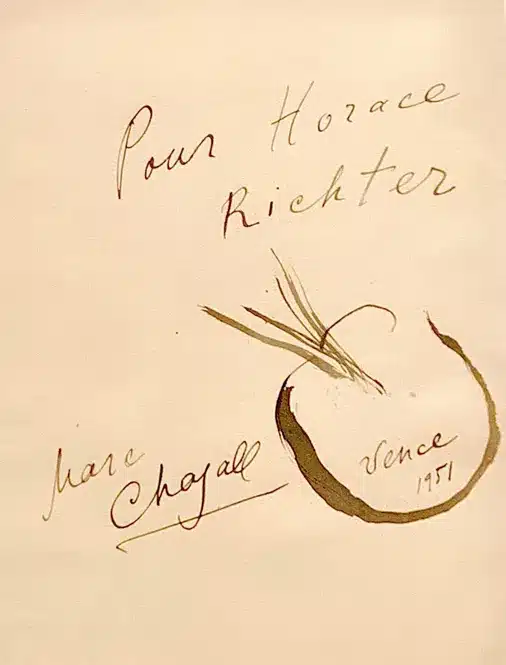
Chagall’s signature carries a calligraphic grace, often in elegant cursive that mirrors the lyricism of his images. It conveys tenderness and imagination, aligning with the romantic and whimsical nature of his art.
Discover fresh inspiration and creative calligraphy signature ideas with our free online tool: calligraphy signature maker.
Henri Matisse – Bold, Expressive Flow
Henri Matisse (1869–1954), a French painter and sculptor, was a master of color and form, leading Fauvism with works like The Dance and Woman with a Hat.
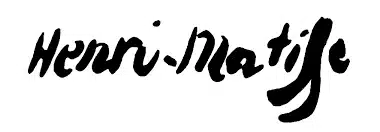
Matisse’s signature is bold and expressive, typically written in a sweeping hand that complements his vivid use of color and simplified forms. It reflects his commitment to joy, balance, and artistic vitality.
Pierre-Auguste Renoir: Elegant, Refined Hand
Pierre-Auguste Renoir (1841–1919), a French Impressionist, is celebrated for luminous scenes like Luncheon of the Boating Party and Dance at Le Moulin de la Galette. His work captured beauty and sensuality.
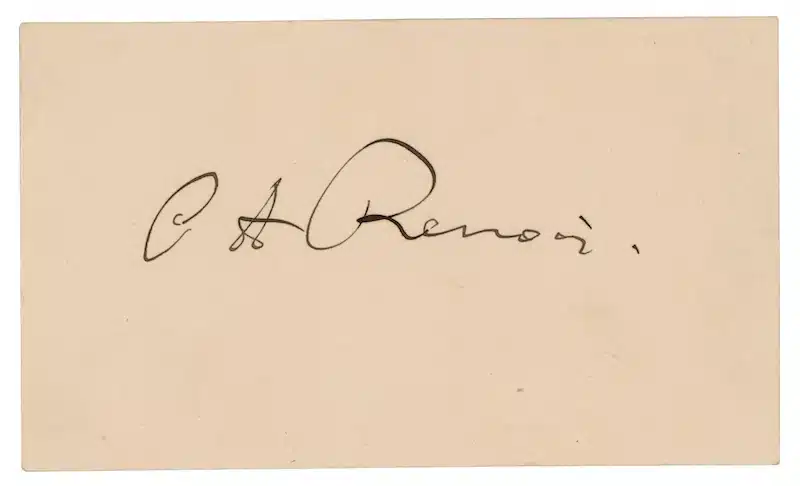
Renoir’s signature is elegant, fluid, and refined, harmonizing with the softness and charm of his brushwork. It adds a gentle finishing touch, often blending gracefully into his compositions.
Frida Kahlo – Honest, Personal Inscription
Frida Kahlo (1907–1954), a Mexican painter, is revered for her deeply personal, symbolic self-portraits like The Two Fridas and Self-Portrait with Thorn Necklace and Hummingbird.
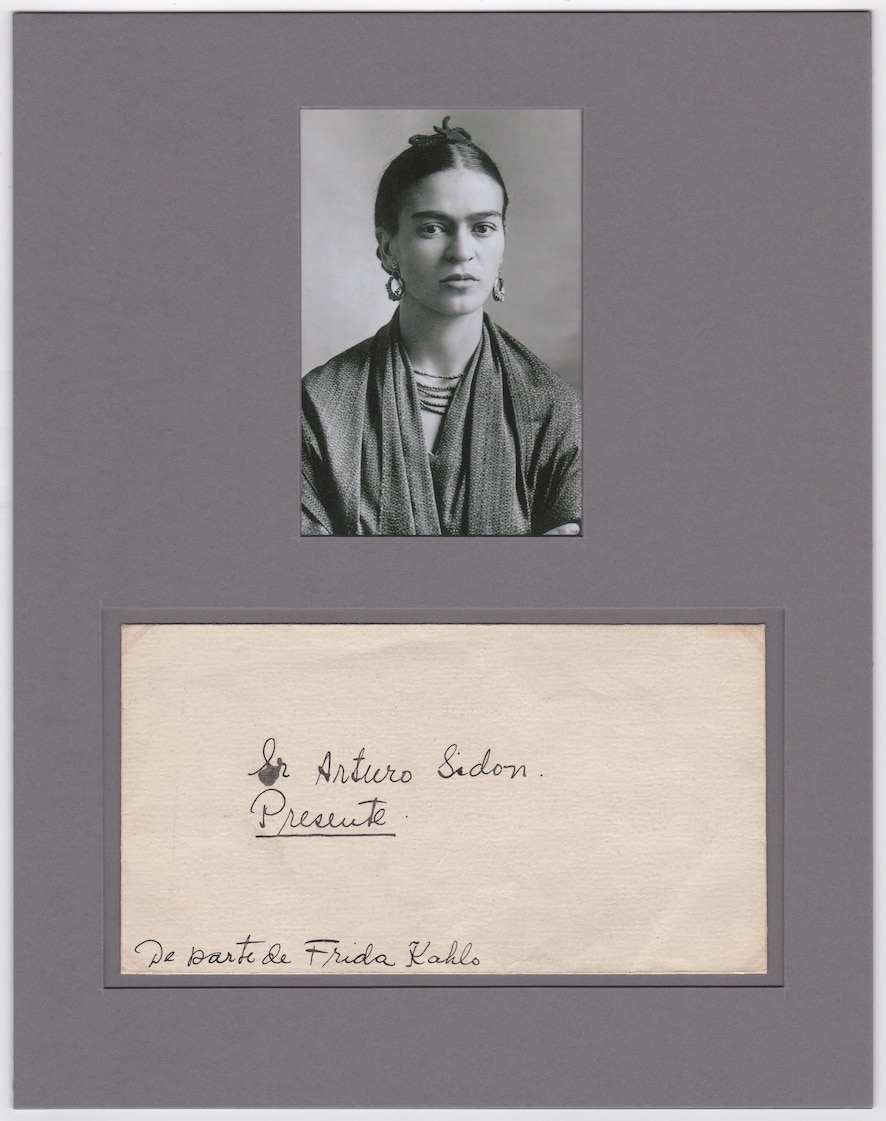
Kahlo’s signature is often small, carefully written, and sometimes accompanied by dedications or dates. It reflects her honesty, resilience, and the intimate storytelling at the heart of her art.
Wassily Kandinsky – Geometric, Precise Mark
Wassily Kandinsky (1866–1944), a Russian painter and art theorist, was a pioneer of abstract art, known for works like Composition VII and Yellow-Red-Blue.

Kandinsky’s signature is typically geometric and precise, echoing his passion for order, rhythm, and the spiritual dimension of color. It aligns seamlessly with the structured energy of his canvases.
If you’re a fan of rare autographs, don’t miss the Top 10 Best Signatures in the World — a curated list of famous VIP signatures that collectors love.
Lee Reynolds – Decorative, Commercial Signature
Lee Reynolds (1936–2017), an American painter, is associated with mass-produced decorative art in the mid-20th century, often signing pieces made in large studio settings.
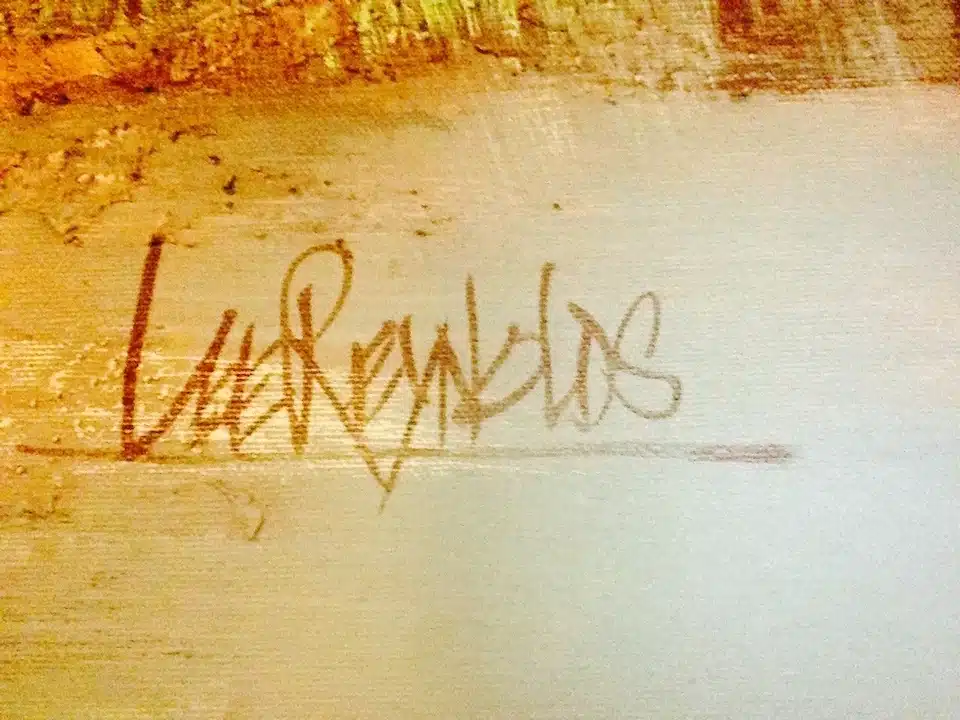
Reynolds’ signature is decorative and consistent, applied across numerous works, sometimes by studio assistants. While widely recognized, it’s often debated in fine art circles for its commercial nature.
Michelangelo – Monumental, Rare Inscription
Michelangelo Buonarroti (1475–1564), an Italian Renaissance titan, created masterpieces like the Sistine Chapel Ceiling and David. His genius spanned sculpture, painting, and architecture.

Michelangelo rarely signed his works, making authentic inscriptions like on the Pietà exceptionally rare. When present, his signature was solemn and monumental, reflecting his profound sense of craftsmanship.
Edward Hopper – Reserved, Crisp Script
Edward Hopper (1882–1967), an American realist, captured modern urban solitude in works like Nighthawks and Automat. His art focuses on light, space, and quiet tension.
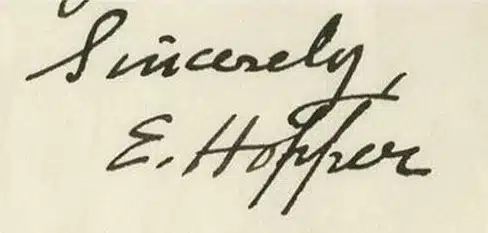
Hopper’s signature is reserved and crisp, usually appearing in neat block letters. It matches the restrained, introspective mood that defines his paintings.
Albrecht Dürer – Masterful, Monogrammed Mark
Albrecht Dürer (1471–1528), a German Renaissance master, was renowned for prints, engravings, and paintings like Melencolia I and The Four Horsemen of the Apocalypse.
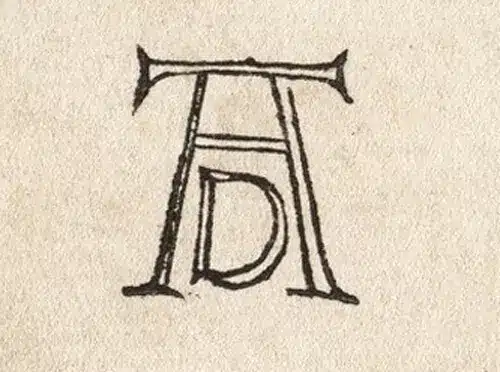
Dürer’s iconic “AD” monogram is one of the most famous artist marks in history, symbolizing precision, craftsmanship, and intellectual rigor. It set a precedent for artists branding their work.
Andrew Wyeth – Subtle, Thoughtful Signature
Andrew Wyeth (1917–2009), an American realist, is known for works like Christina’s World, reflecting rural American life with quiet emotion.

Wyeth’s signature is subtle and often small, reflecting his modest, introspective nature. It integrates into the painting without drawing attention away from the image’s quiet power.
Caroline Burnett – Flowing, Decorative Script
Caroline Burnett, a lesser-known artist associated with Parisian street scenes and impressionist landscapes, was active in the mid-20th century.
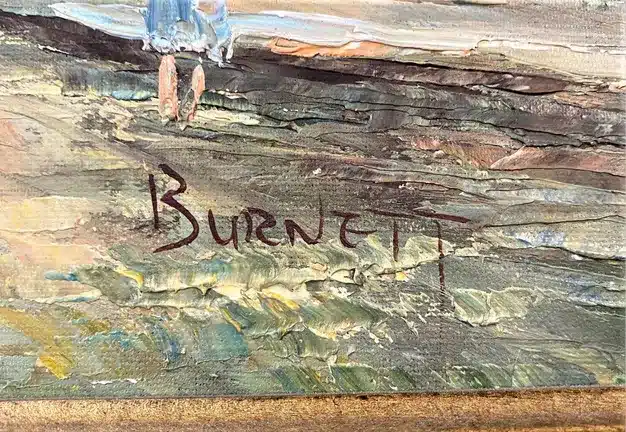
Burnett’s signature is flowing and decorative, often featuring elegant cursive. While not extensively documented, it adds a romantic charm to her atmospheric cityscapes.
Frank Stella – Minimalist, Contemporary Mark
Frank Stella (b. 1936), an American minimalist and abstract painter, is known for works like Die Fahne Hoch! and his shaped canvases. His art defies pictorial illusion, focusing on material and form.
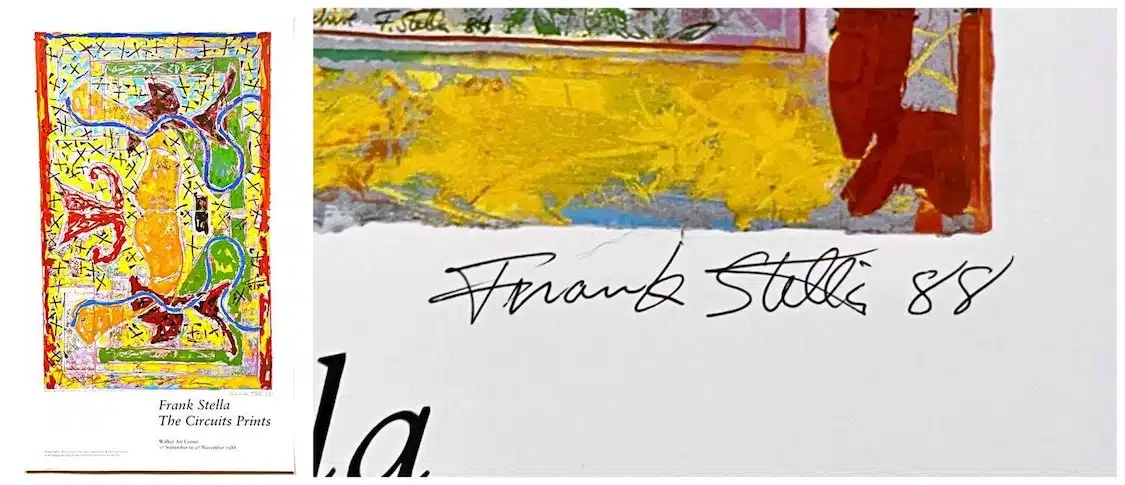
Stella’s signature is minimalist, often small and discreet, reflecting his rejection of narrative in favor of pure visual experience. It aligns with his emphasis on formal innovation and process.
Jasper Johns – Layered, Conceptual Mark
Jasper Johns (b. 1930), an American painter and sculptor, is known for his use of everyday symbols like flags, numbers, and targets in works such as Flag and Numbers in Color. A key figure in the transition from Abstract Expressionism to Pop Art, Johns explores perception and meaning.
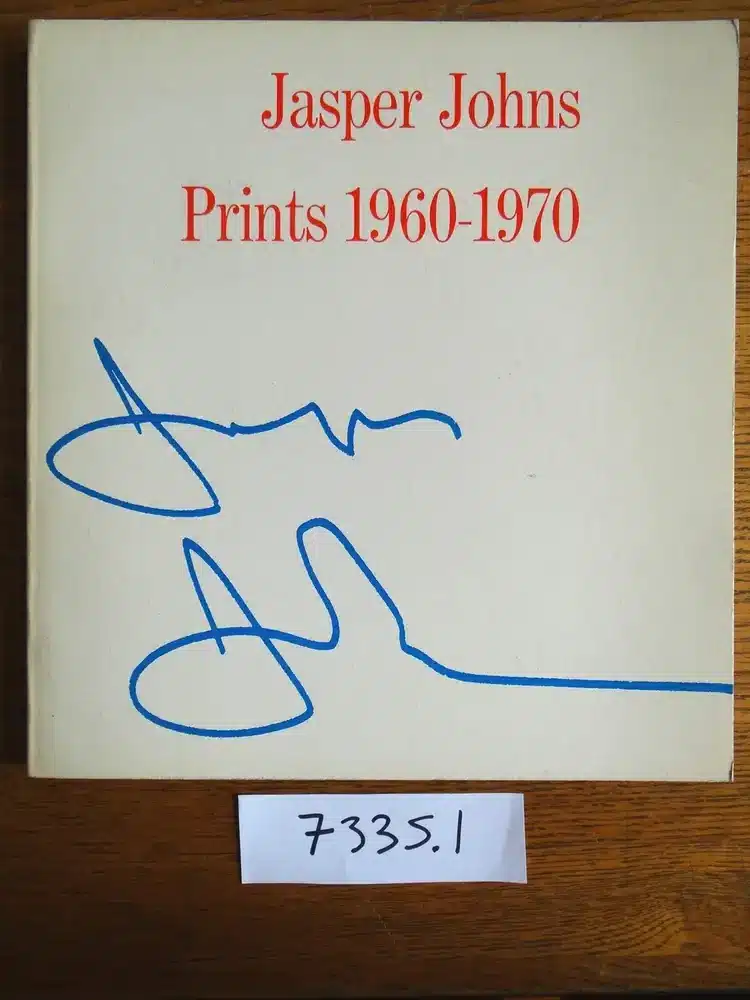
His signature is layered and deliberate, sometimes integrated into the artwork, reflecting his conceptual approach and interest in the tension between the familiar and the abstract.
Nam June Paik – Experimental, Avant-Garde Touch
Nam June Paik (1932–2006), a Korean-American artist, was a pioneer of video art and media installations, with works like TV Buddha and Electronic Superhighway. His art bridged technology, performance, and interactivity.

Paik’s signature often carries an experimental feel, sometimes playful or rough, reflecting his irreverent spirit and innovative fusion of art and technology.
David Hockney – Bright, Confident Flow
David Hockney (b. 1937), an English painter, draftsman, and photographer, is celebrated for vibrant works like A Bigger Splash and Portrait of an Artist. A leading figure in Pop Art, his practice spans painting, photography, and digital art.
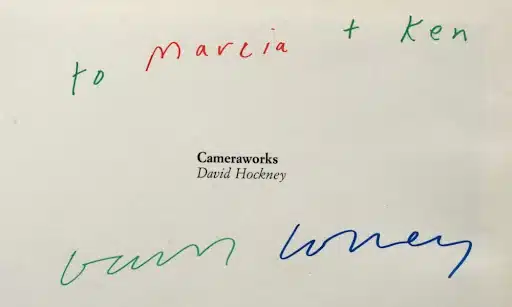
Hockney’s signature is bright and confident, often with a painterly flair that mirrors his bold use of color and personal, sunlit style.
Antonio Artist – Fluid, Decorative Style
“Antonio” likely refers to Antonio Lopez (1943–1987), a Puerto Rican-American fashion illustrator renowned for his dynamic drawings for magazines like Vogue and Harper’s Bazaar.
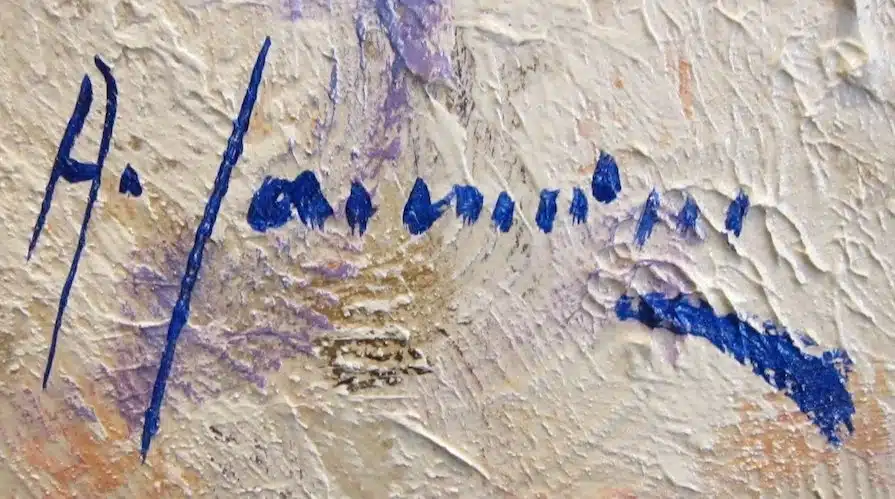
His signature is fluid and decorative, echoing the graceful lines and energy of his fashion sketches.
George Inness (C. Inness Artist) – Romantic, Spiritual Mark
George Inness (1825–1894), an American landscape painter, was a key figure in the Tonalist movement, known for works like Peace and Plenty. His art balanced realism and spiritual expression.

Inness’ signature is typically modest and romantic, matching the atmospheric, almost mystical mood of his landscapes.
Ellsworth Kelly – Minimalist, Clear Script
Ellsworth Kelly (1923–2015), an American painter, sculptor, and printmaker, was a master of hard-edge abstraction, known for bold color fields and simplified forms.
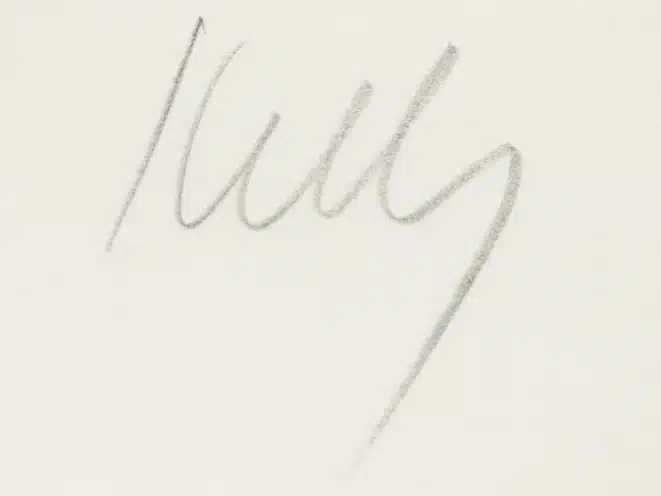
Kelly’s signature is minimalist and clear, reflecting the sharp precision and reductive elegance of his art.
Gustav Klimt – Ornate, Decorative Signature
Gustav Klimt (1862–1918), an Austrian Symbolist painter, is famed for masterpieces like The Kiss and Portrait of Adele Bloch-Bauer I. His works shimmer with gold leaf, sensuality, and symbolism.
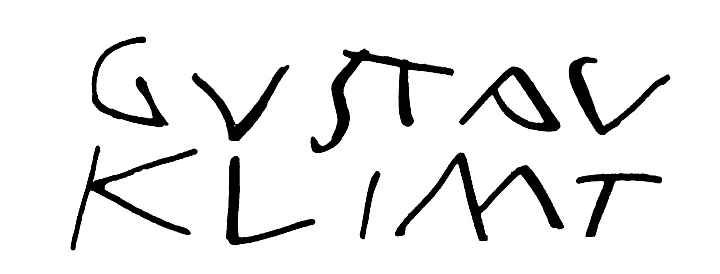
Klimt’s signature is ornate and decorative, often complementing the opulence of his compositions, and adds a layer of personal ornamentation.
Wayne Thiebaud – Playful, Painterly Signature
Wayne Thiebaud (1920–2021), an American painter, is best known for colorful depictions of cakes, pies, and candy, blending Pop Art with realism. His signature has a playful, painterly quality, reflecting the charm and joy he infused into everyday subjects.

Agnes Martin – Minimal, Delicate Touch
Agnes Martin (1912–2004), an American minimalist, is known for subtle grids and muted palettes in works like Untitled No. 5.
Her signature is delicate and restrained, mirroring the meditative simplicity and spiritual serenity of her paintings.
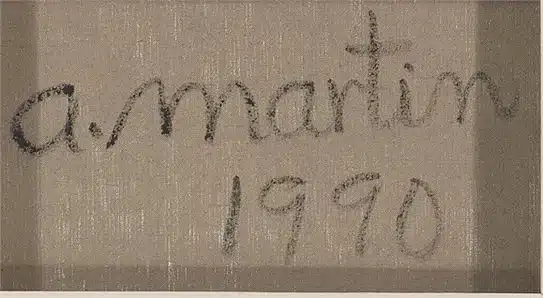
A.J. Casson – Bold, Canadian Group of Seven Mark
A.J. Casson (1898–1992), a Canadian landscape painter, was part of the Group of Seven, capturing Ontario’s countryside in works like Village Street.
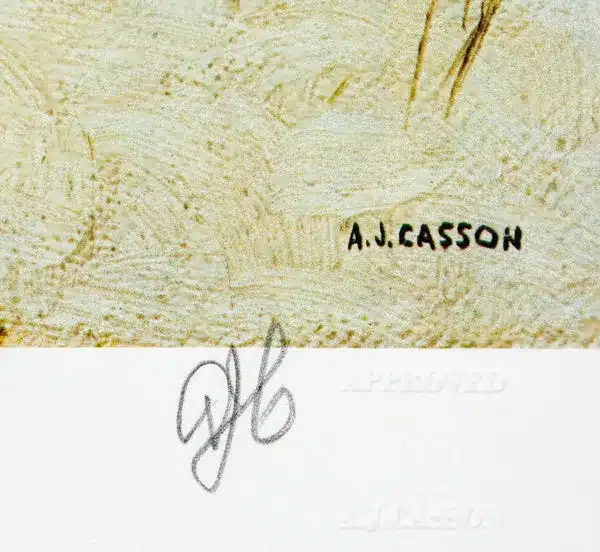
Casson’s signature is bold and assertive, in keeping with the rugged national pride of the Group of Seven’s artistic mission.
Robert Cox – Decorative, Consistent Signature
Robert Cox is known for decorative floral paintings, especially popular in commercial and collectible art markets.
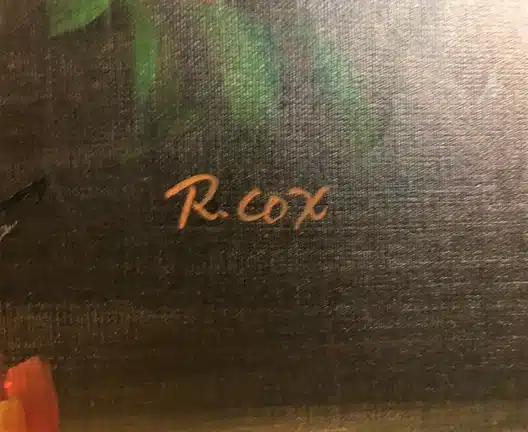
His signature is decorative, consistent, and often elegantly placed, contributing to the collectible appeal of his works.
Brice Marden – Reserved, Minimal Mark
Brice Marden (1938–2023), an American minimalist, is known for monochromatic panels and later gestural abstractions.
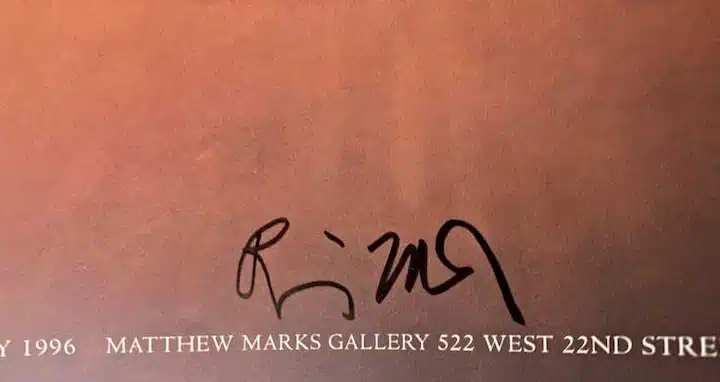
His signature is reserved, sometimes nearly invisible, reflecting his introspective approach and emphasis on surface and process.
Jean Baptiste Camille Corot – Classic, Graceful Script
Corot (1796–1875), a French painter, bridged Neoclassicism and Impressionism, known for landscapes like Ville d’Avray.

His signature is classic and graceful, aligning with the lyrical, atmospheric quality of his scenes.
Käthe Kollwitz – Strong, Emotive Signature
Käthe Kollwitz (1867–1945), a German artist, created powerful prints and sculptures addressing war, poverty, and grief.
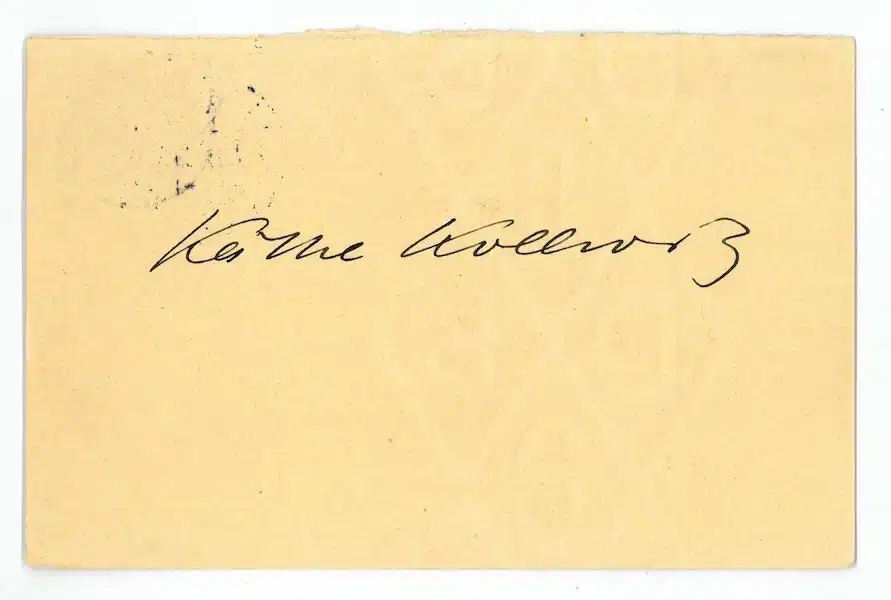
Her signature is strong, direct, and emotionally resonant, much like the profound social commentary in her work.
Paul Klee – Whimsical, Playful Script
Paul Klee (1879–1940), a Swiss-German artist, blended surrealism, expressionism, and abstraction in works like Twittering Machine.
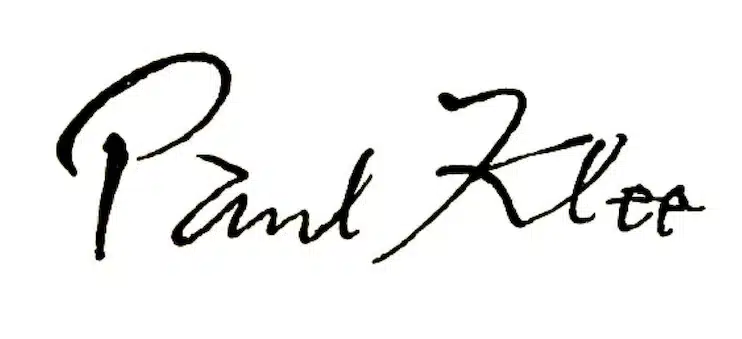
Klee’s signature is whimsical and playful, often incorporated into the artwork itself, mirroring his humor and inventiveness.
Peter Doig – Loose, Painterly Mark
Peter Doig (b. 1959), a Scottish painter, is acclaimed for dreamlike landscapes such as Canoe-Lake and White Canoe.
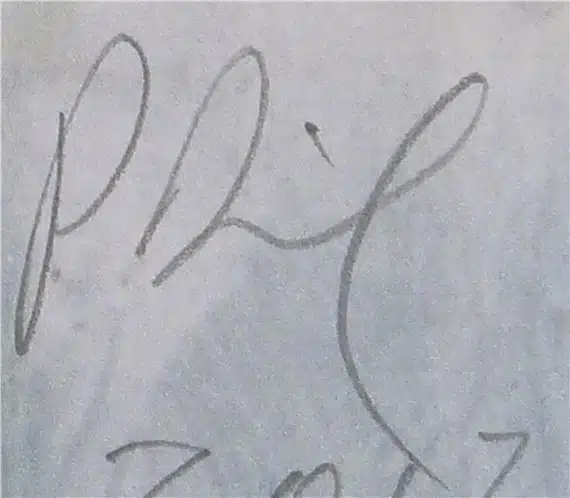
Doig’s signature is loose and painterly, reflecting the mysterious, almost cinematic atmosphere of his canvases.
René Magritte – Surreal, Precise Mark
René Magritte (1898–1967), a Belgian Surrealist, is known for witty, thought-provoking works like The Son of Man and The Treachery of Images.

Magritte’s signature is precise and understated, reflecting his cerebral approach, often positioned unobtrusively to not distract from the visual paradoxes he created.
Roy Lichtenstein – Bold, Comic-Inspired Script
Roy Lichtenstein (1923–1997), an American Pop artist, is celebrated for comic-strip–style works like Whaam! and Drowning Girl.
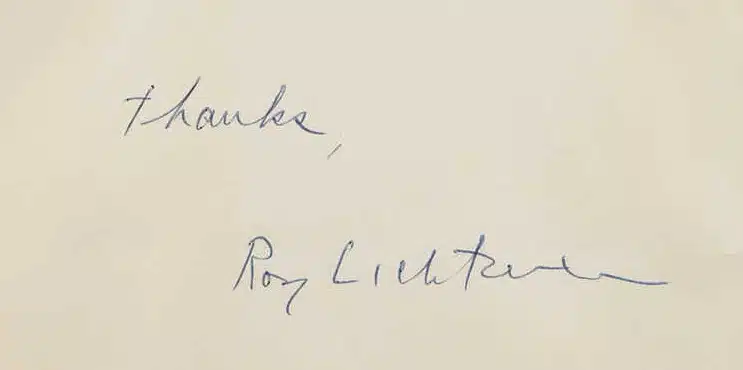
His signature is bold and clear, echoing the graphic punch of his art, with a style that reinforces the interplay between fine art and mass media.
Sol LeWitt – Minimal, Systematic Signature
Sol LeWitt (1928–2007), an American conceptual and minimalist artist, is famed for wall drawings and geometric structures.
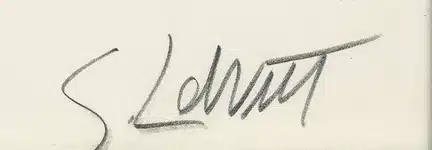
LeWitt’s signature is minimal and systematic, reflecting his emphasis on idea over execution and aligning with his conceptual frameworks.
Henri de Toulouse-Lautrec: Expressive, Painterly Mark
Henri de Toulouse-Lautrec (1864–1901), a French Post-Impressionist, captured Parisian nightlife in works like At the Moulin Rouge.
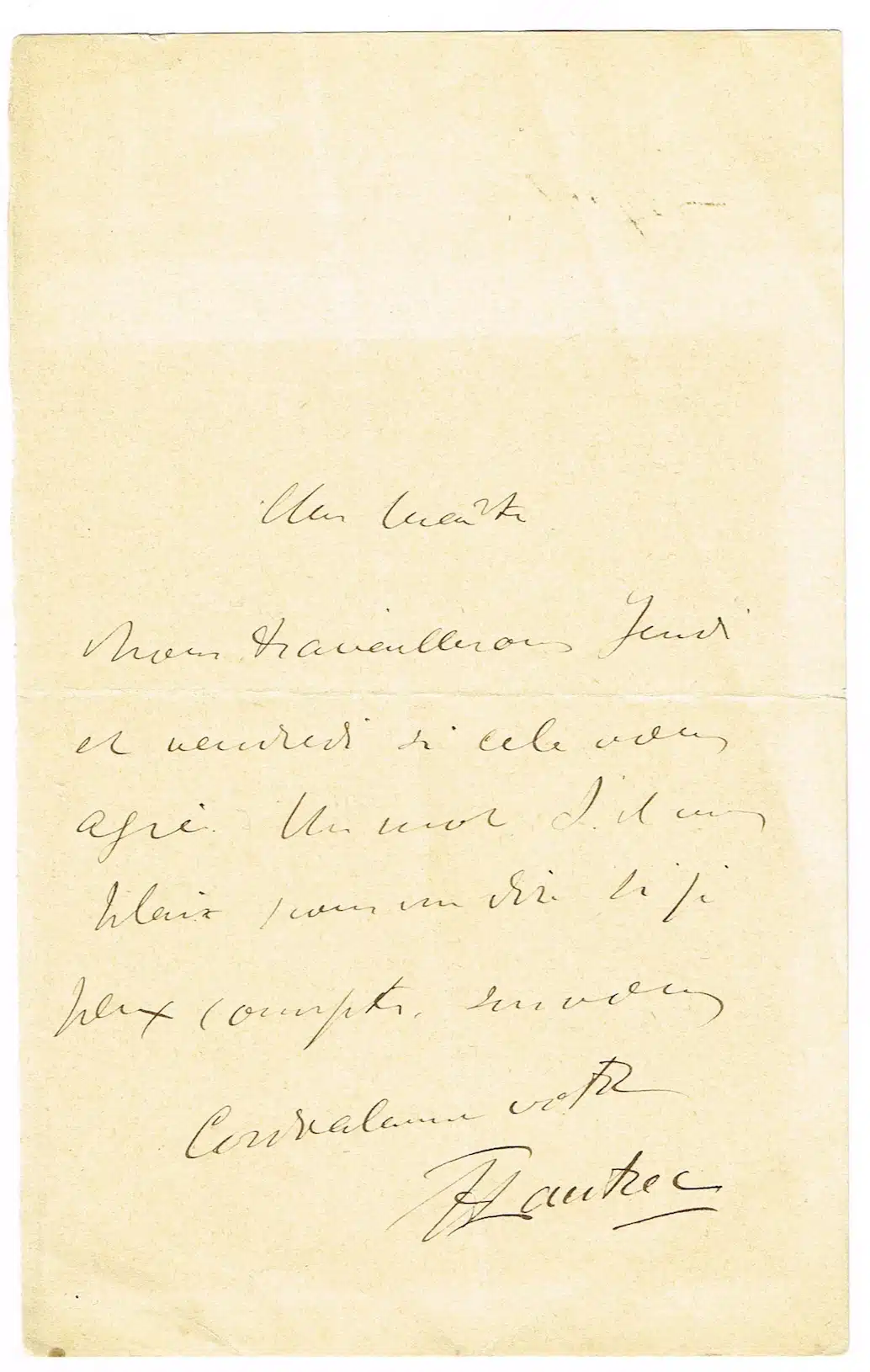
His signature is expressive and often painterly, matching the vibrant energy and intimate observation of his cabaret scenes.
Aldo Luongo – Elegant, Decorative Script
Aldo Luongo (b. 1940), an Argentine-born painter, is known for romantic, impressionistic works and his “Longo” figures.
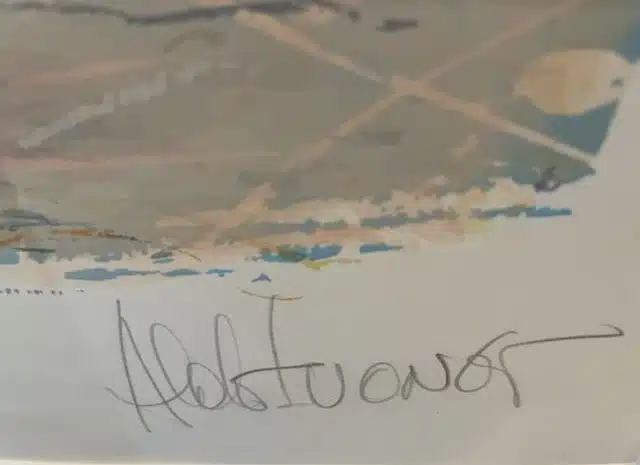
His signature is elegant and decorative, often looping gracefully, adding a flourish that complements the movement in his paintings.
Franco – Commercial, Decorative Signature
“Franco” commonly refers to decorative art mass-produced for commercial markets, often landscapes or florals.
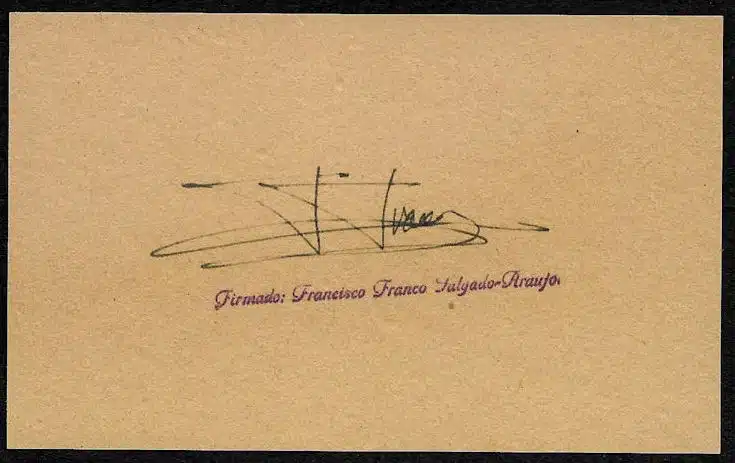
The signature is typically decorative and consistent, serving as a recognizable mark for collectors of accessible art.
Winslow Homer – Solid, Assertive Script
Winslow Homer (1836–1910), an American realist, is acclaimed for maritime scenes and works like The Gulf Stream.

Homer’s signature is solid and assertive, reflecting the rugged, direct character of his subjects and his mastery of light and atmosphere.
Carl Larsson – Delicate, Personal Script
Carl Larsson (1853–1919), a Swedish painter and illustrator, is known for charming depictions of family life and interiors, such as Brita with Cat.
His signature is delicate and personal, often blending into the warm, intimate tone of his art.

Carl Valente – Decorative, Consistent Mark
Carl Valente (b. mid-20th century), an American painter, is known for colorful abstract and floral works.
Valente’s signature is decorative and consistently applied, adding a recognizable personal mark to his vibrant compositions.
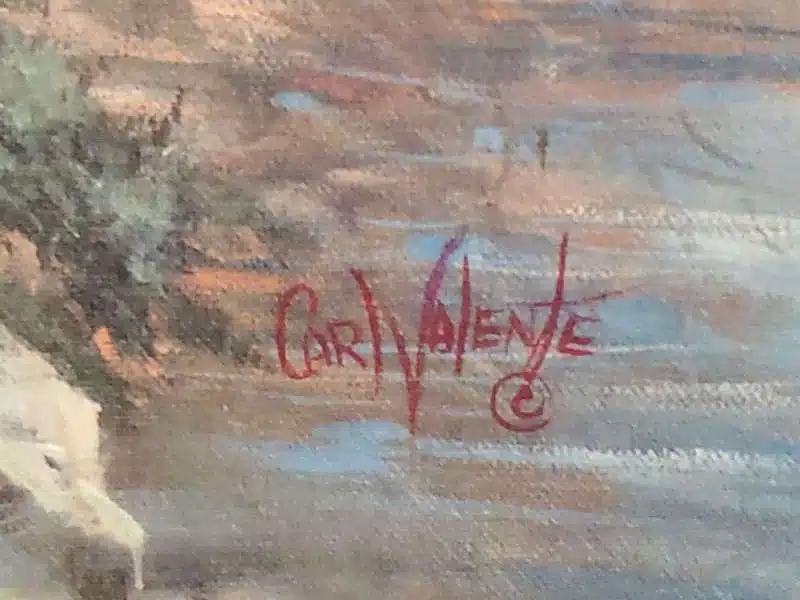
Cy Twombly – Loose, Scribbled Inscription
Cy Twombly (1928–2011), an American painter, is known for gestural, calligraphic works blending painting and drawing.
Twombly’s signature is loose and scribbled, often integrated into the artwork, reflecting his fascination with mark-making, myth, and memory.
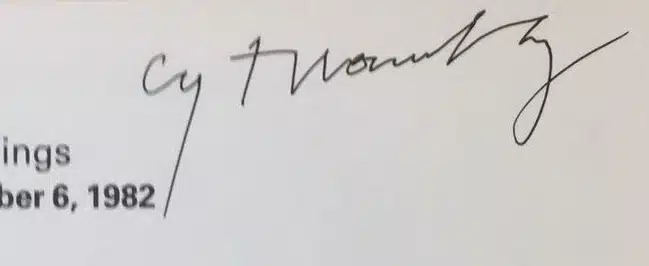
Damien Hirst – Sharp, Modern Mark
Damien Hirst (b. 1965), a British contemporary artist, shocked and fascinated with works like The Physical Impossibility of Death in the Mind of Someone Living.
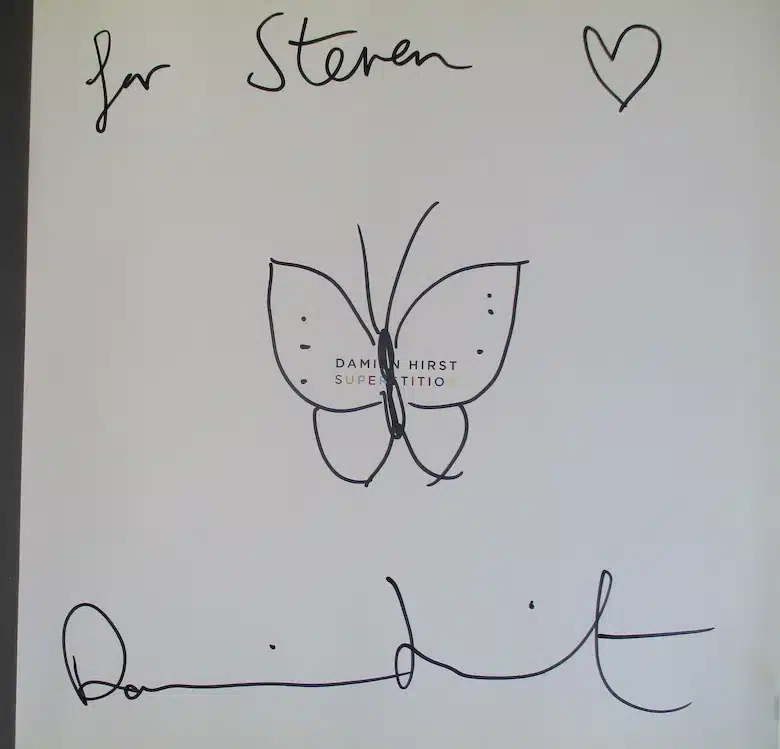
Hirst’s signature is sharp and modern, often accompanying works with conceptual and provocative themes, adding an extra layer of authorship.
Diego Rivera – Bold, Political Script
Diego Rivera (1886–1957), a Mexican muralist, is renowned for vast murals portraying history and social themes, such as Detroit Industry Murals.
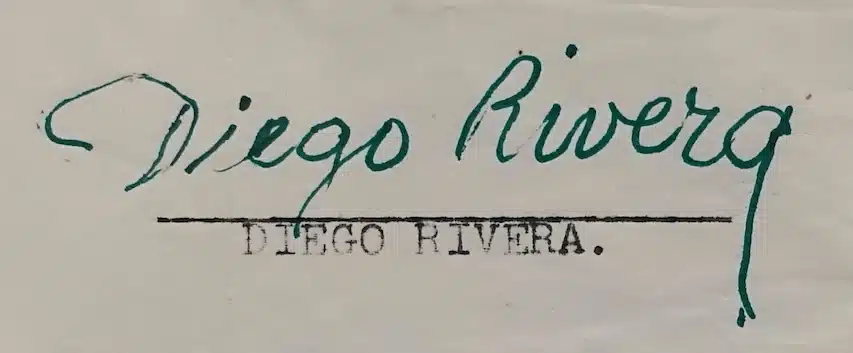
Rivera’s signature is bold and clear, reflecting his political passion and his monumental approach to public art.
Ferrante Artist – Decorative, Commercial Signature
“Ferrante” appears on various decorative paintings, often landscapes or seascapes, in commercial art markets.
The signature is decorative and consistent, helping collectors identify works in this decorative niche.
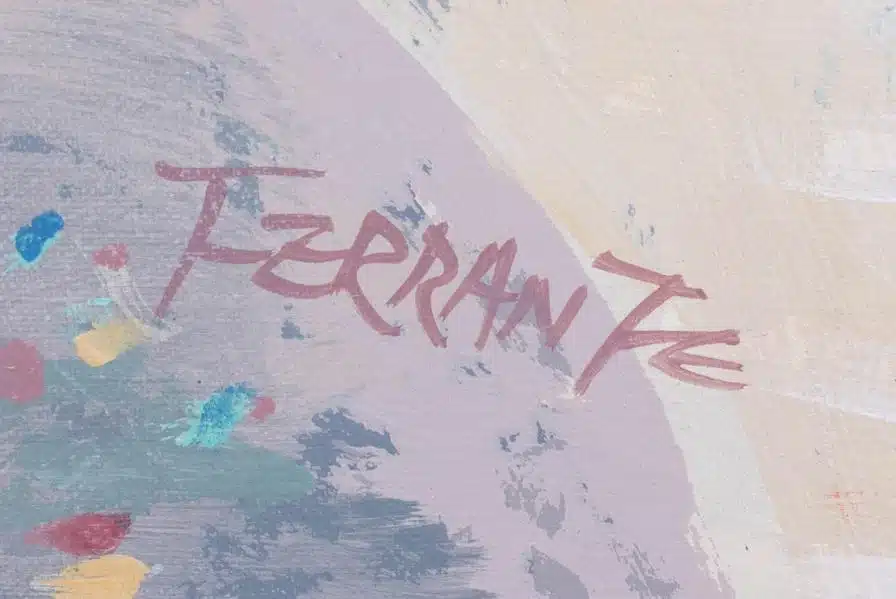
Fritz Scholder – Powerful, Contemporary Mark
Fritz Scholder (1937–2005), a Native American painter, fused Expressionism with Native themes in works like Indian with Beer Can.
Scholder’s signature is powerful and confident, often reflecting his bold brushwork and modern reimagining of Indigenous identity.

Georges Braque – Cubist, Structured Script
Georges Braque (1882–1963), a French artist, co-founded Cubism alongside Picasso, transforming still life and landscape painting.
Braque’s signature is structured and composed, reflecting the geometric order and intellectual rigor of his cubist explorations.

Georgia O’Keeffe – Refined, Graceful Script
Georgia O’Keeffe (1887–1986), an American modernist, is celebrated for floral close-ups and desert landscapes like Jimson Weed.
O’Keeffe’s signature is refined and graceful, mirroring the clarity and sensuality of her artistic vision.
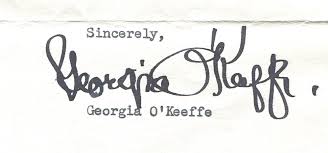
Katsushika Hokusai – Bold, Woodblock Signature
Hokusai (1760–1849), a Japanese ukiyo-e master, is best known for The Great Wave off Kanagawa.
His signature, typically in kanji characters, appears boldly on woodblock prints, anchoring his place in Japanese art history and signaling masterful craftsmanship.
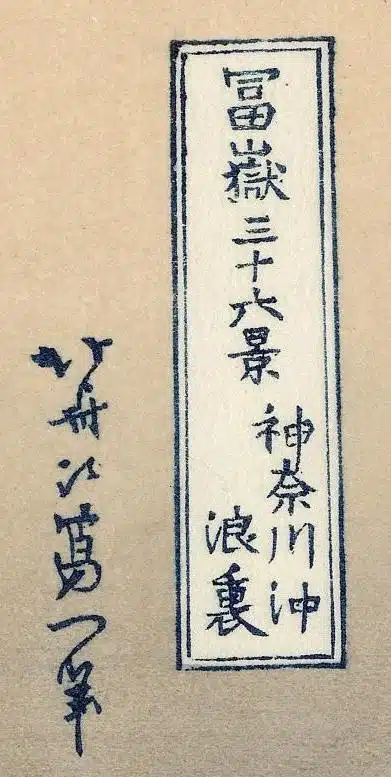
Lucio Fontana – Minimal, Assertive Mark
Lucio Fontana (1899–1968), an Italian-Argentinian artist, pioneered the Spatialist movement, famous for his cut canvases (Concetto spaziale series).
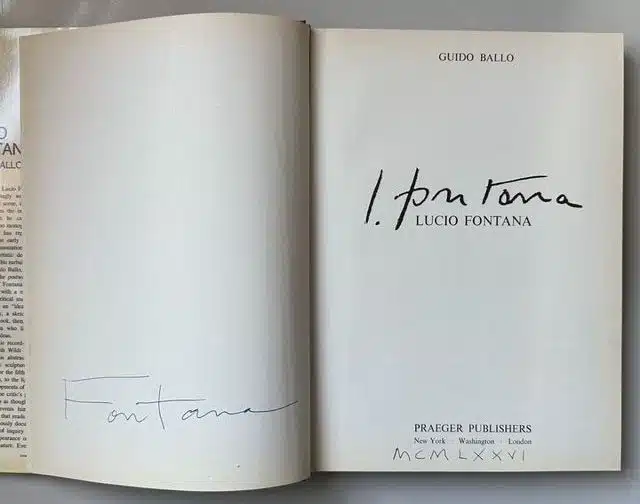
Fontana’s signature is minimal yet assertive, often placed alongside his radical interventions, underlining his conceptual disruptions of the picture plane.
✍️ Artistic Signature Ideas for Modern Creators
For today’s artists and creators looking to develop a distinctive mark, consider:
- Simplicity: Keep it legible and consistent
- Style alignment: Reflect your artistic voice—minimalist, bold, expressive?
- Symbolism: Use motifs that echo your themes
- Medium compatibility: Ensure your signature works on all surfaces
Pro tip: Try the AISIGNATOR Signature Generator to explore unique artistic signature ideas powered by AI.
🔍 Identifying an Artist Signature: Expert Tips & Tools
To identify an artist signature correctly, follow these steps:
- Examine the handwriting: Is it consistent with verified examples?
- Check the medium & style: Does it match the period and materials?
- Research artist signature databases: Use tools like art signature directories.
- Look up artist by signature: Use online apps or consult auction records.
- Seek expert help: If in doubt, hire a professional authenticator.
Remember, a genuine artwork signature adds enormous value, but fakes abound—stay vigilant.
✨ Make your mark with confidence! Learn from our in-depth signature analysis and refine your style today.
🚨 Common Challenges in Verifying Artwork Signatures
Even experts face challenges when authenticating art signatures:
- Forgeries that closely mimic the real signature
- Artists whose signatures evolved over time
- Works signed posthumously by assistants or forgers
- Damage or fading obscuring part of the signature
- Misinterpretation of initials or stylized marks
Key tip: Never rely solely on the signature—provenance and documentation matter too.
Looking for signature inspiration with a touch of faith?
Explore beautiful, meaningful styles in our Christian Signature guide and create your own faith-centered autograph.
💬 FAQs about Painter Signatures
❓ What makes an art signature authentic?
Consistency with known examples, correct placement, and period-appropriate materials.
❓ How do I look up an artist by their signature?
Use online databases, signature directories, and consult auction records.
❓ Are all artwork signatures handwritten?
Most are, but some modern works may use stamps or digital marks.
❓ Can AI help with identifying artist signatures?
Yes! Tools like AISIGNATOR’s Signature Analysis can analyze handwriting traits to flag inconsistencies.
Why Every Signature on a Painting Tells a Story?
A painter’s signature is the final brushstroke of a masterpiece—a declaration of ownership, identity, and intent. Whether it’s the bold scrawl of a modernist or the delicate monogram of a Renaissance master, every mark carries history.
By understanding, identifying, and appreciating painter signatures, we deepen our connection to art and preserve its legacy for generations to come.
📜 Elegant & Stylish Signature Examples
- 📚 Signature Dictionary (A–Z)
- 🟢 20+ Coolest Signatures
- 🌈 10+ Billionaire Signatures
- 👨👨👦👦 50+ Famous Signature
- 🖼️ Signature Gallery
- 🌟 Best Signature Styles for My Name
- 25+ Infinity Signature Ideas & Unique Autograph Samples
- 35+ Simple Signature Ideas: Best, Easy & Minimalist Examples
- 30+ Signature Suggestions for My Name: Creative Ideas
- 💡 100+ Sample Signature Ideas

